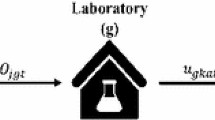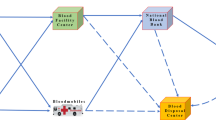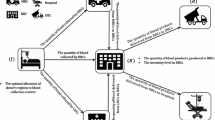Abstract
We propose a fuzzy-robust multi-objective optimization model for blood supply chain network design in disaster relief. The problem aims to minimize (1) the expected total cost of the system, (2) the implicit cost associated with patients’ waiting in hospitals, and (3) the unsatisfied demands. To model patients’ waiting and to improve the effectiveness of relief activities by decreasing congestion in hospitals, a queuing framework is utilized. A robust possibilistic programming approach is applied to capture the epistemic uncertainty of parameters and provide risk-averse solutions for policymakers. Given the conflicting objectives sought, we use multi-objective decision-making techniques, including the Torabi and Hasini approach and \(\varepsilon\)-constrained method. Experimentation on a real-life case study confirms that the proposed framework can help decision-makers adopt suitable strategies for planning blood collection and delivery in emergencies. The results obtained show that substantial improvements in the service quality could be achieved at modest increases in the network cost by properly locating facilities using our model. We also observed that both the service level and the service quality remain relatively stable over a wide range of model parameter values, highlighting the robust nature of the proposed approach. Based on our findings, we recommend implementing risk-pooling strategies, setting realistic service level targets, and incorporating service equity as an objective. Although our model accounts for many realistic considerations, it overlooks some relevant issues like network disruptions to remain tractable, which is worthy of further investigation in future research.







Similar content being viewed by others
References
Acar M, Kaya O (2019) A healthcare network design model with mobile hospitals for disaster preparedness: a case study for Istanbul earthquake. Transp Res Part E Log Transp Rev 130:273–292
Amiri A (1997) Solution procedures for the service system design problem. Comput Oper Res 24(1):49–60
Arani M, Chan Y, Liu X, Momenitabar M (2021) A lateral resupply blood supply chain network design under uncertainties. Appl Math Model 93:165–187
Baesler F, Martínez C, Yaksic E, Herrera C (2011) Logistic and production process in a regional blood center: modeling and analysis. Rev Med Chil 139(9):1150–1156
Beale E, Forrest JJ (1976) Global optimization using special ordered sets. Math Program 10(1):52–69
Beliën J, Forcé H (2012) Supply chain management of blood products: a literature review. Eur J Oper Res 217(1):1–16
Berman O, Larson RC (1985) Optimal 2-facility network districting in the presence of queuing. Transp Sci 19(3):261–277
Bozorgi-Amiri A, Jabalameli MS, Al-e Hashem SM (2013) A multi-objective robust stochastic programming model for disaster relief logistics under uncertainty. OR Spectrum 35(4):905–933
Cheraghali A (2012) Overview of blood transfusion system of Iran: 2002–2011. Iran J Public Health 41(8):89
Cheraghi S, Hosseini-Motlagh SM (2017) Optimal blood transportation in disaster relief considering facility disruption and route reliability under uncertainty. Int J Transp Eng 4(3):225–254
Darestani SA, Hemmati M (2019) Robust optimization of a bi-objective closed-loop supply chain network for perishable goods considering queue system. Comput Ind Eng 136:277–292
Dillon M, Oliveira F, Abbasi B (2017) A two-stage stochastic programming model for inventory management in the blood supply chain. Int J Prod Econ 187:27–41
Dubois D, Prade H (1987) The mean value of a fuzzy number. Fuzzy Sets Syst 24(3):279–300
Dubois D, Fargier H, Fortemps P (2003) Fuzzy scheduling: modelling flexible constraints vs. coping with incomplete knowledge. Eur J Oper Res 147(2):231–252
Elhedhli S, Wang Y, Saif A (2018) Service system design with immobile servers, stochastic demand and concave-cost capacity selection. Comput Oper Res 94:65–75
Fahimnia B, Jabbarzadeh A, Ghavamifar A, Bell M (2017) Supply chain design for efficient and effective blood supply in disasters. Int J Prod Econ 183:700–709
Gross D (2008) Fundamentals of queueing theory. Wiley, Hoboken
Haeri A, Hosseini-Motlagh SM, Ghatreh Samani MR, Rezaei M (2020) A mixed resilient-efficient approach toward blood supply chain network design. Int Trans Oper Res 27(4):1962–2001
Haghjoo N, Tavakkoli-Moghaddam R, Shahmoradi-Moghadam H, Rahimi Y (2020) Reliable blood supply chain network design with facility disruption: a real-world application. Eng Appl Artif Intell 90
Haijema R, van Dijk N, van der Wal J, Sibinga CS (2009) Blood platelet production with breaks: optimization by SDP and simulation. Int J Prod Econ 121(2):464–473
Haimes Y (1971) On a bicriterion formulation of the problems of integrated system identification and system optimization. IEEE Trans Syst Man Cybern 1(3):296–297
Hamdan B, Diabat A (2020) Robust design of blood supply chains under risk of disruptions using Lagrangian relaxation. Transp Res Part E Log Transp Rev 134
Hess J, Thomas M (2003) Blood use in war and disaster: lessons from the past century. Transfusion 43(11):1622–1633
Hosseini-Motlagh SM, Larimi NG, Nejad MO et al (2020a) A qualitative, patient-centered perspective toward plasma products supply chain network design with risk controlling. Oper Res pp 1–46
Hosseini-Motlagh SM, Samani MRG, Cheraghi S (2020b) Robust and stable flexible blood supply chain network design under motivational initiatives. Socio Econ Plan Sci 70
Hosseini-Motlagh SM, Samani MRG, Homaei S (2020c) Toward a coordination of inventory and distribution schedules for blood in disasters. Socio Econ Plan Sci 100897
Hosseinifard Z, Abbasi B (2018) The inventory centralization impacts on sustainability of the blood supply chain. Comput Oper Res 89:206–212
How much blood is in your body and how much you can lose. https://www.healthline.com/health/how-much-blood-in-human-body#:~:text=Adults%3A%20The%20average%20adult%20weighing,women%20who%20are%20not%20pregnant. Accessed 25 Oct 2020
Inuiguchi M, Ramık J (2000) Possibilistic linear programming: a brief review of fuzzy mathematical programming and a comparison with stochastic programming in portfolio selection problem. Fuzzy Sets Syst 111(1):3–28
Jabbarzadeh A, Fahimnia B, Seuring S (2014) Dynamic supply chain network design for the supply of blood in disasters: a robust model with real world application. Transp Res Part E Log Transp Rev 70:225–244
Japanese International Cooperation Agency. https://www.jica.go.jp/english/. Accessed 24 Oct 2020
Kleinrock L (1976) Queueing systems, volume 2: computer applications, vol 66. Wiley, New York
Lai YJ, Hwang CL (1993) Possibilistic linear programming for managing interest rate risk. Fuzzy Sets Syst 54(2):135–146
Larimi NG, Yaghoubi S, Hosseini-Motlagh SM (2019) Itemized platelet supply chain with lateral transshipment under uncertainty evaluating inappropriate output in laboratories. Socio Econ Plan Sci 68
Larson RC (1974) A hypercube queuing model for facility location and redistricting in urban emergency services. Comput Oper Res 1(1):67–95
Xq Li, Zhang B, Li H (2006) Computing efficient solutions to fuzzy multiple objective linear programming problems. Fuzzy Sets Syst 157(10):1328–1332
Liu B (1999) Dependent-chance programming with fuzzy decisions. IEEE Trans Fuzzy Syst 7(3):354–360
Liu B, Iwamura K (1998) Chance constrained programming with fuzzy parameters. Fuzzy Sets Syst 94(2):227–237
Liu B, Liu YK (2002) Expected value of fuzzy variable and fuzzy expected value models. IEEE Trans Fuzzy Syst 10(4):445–450
Mahmoudian SM, Pourfath EA (2006) An overview analysis of blood donation in the Islamic Republic of Iran
Mavrotas G (2009) Effective implementation of the \(\varepsilon\)-constraint method in multi-objective mathematical programming problems. Appl Math Comput 213(2):455–465
Miettinen K, Mäkelä M (1995) Interactive bundle-based method for nondifferentiable multiobjeective optimization: Nimbus. Optimization 34(3):231–246
Miettinen K, Mäkelä MM (2006) Synchronous approach in interactive multiobjective optimization. Eur J Oper Res 170(3):909–922
Pishvaee MS, Razmi J, Torabi SA (2012) Robust possibilistic programming for socially responsible supply chain network design: a new approach. Fuzzy Sets Syst 206:1–20
Pouraliakbari M, Mohammadi M, Mirzazadeh A (2017) Location of heath care facilities in competitive and user choice environment. J Ind Syst Eng 10(special issue on healthcare):24–54
Pouraliakbari M, Mohammadi M, Mirzazadeh A (2018) Analysis of maximal covering location-allocation model for congested healthcare systems in user choice environment. Int J Ind Syst Eng 28(2):240–274
Pouraliakbari-Mamaghani M, Mohammadi M, Arshadi-Khamseh A, Naderi B (2020) A bi-objective robust possibilistic programming model for blood supply chain design in the mass casualty event response phase: a m/m/1/k queuing model with real world application. Int J Oper Res
Pouraliakbarimamaghani M, Mohammadi M, Mirzazadeh A (2017) A queuing location–allocation model for a capacitated health care system
Pouraliakbarimamaghani M, Mohammadi M, Mirzazadeh A (2018) A multi-objective location–allocation model in mass casualty events response. J Model Manag
Pratt M, Grindon A (1982) Computer simulation analysis of blood donor queueing problems. Transfusion 22(3):234–237
Rahmani D (2019) Designing a robust and dynamic network for the emergency blood supply chain with the risk of disruptions. Ann Oper Res 283(1):613–641
Rezaie F, Panahi M (2015) Gis modeling of seismic vulnerability of residential fabrics considering geotechnical, structural, social and physical distance indicators in Tehran using multi-criteria decision-making techniques. Nat Hazards Earth Syst Sci 15(3)
Şahin G, Süral H, Meral S (2007) Locational analysis for regionalization of Turkish red crescent blood services. Comput Oper Res 34(3):692–704
Salehi F, Mahootchi M, Husseini SMM (2019) Developing a robust stochastic model for designing a blood supply chain network in a crisis: a possible earthquake in Tehran. Ann Oper Res 283(1–2):679–703
Samani MRG, Hosseini-Motlagh SM (2019) An enhanced procedure for managing blood supply chain under disruptions and uncertainties. Ann Oper Res 283(1):1413–1462
Samani MRG, Hosseini-Motlagh SM (2020) A robust framework for designing blood network in disaster relief: a real-life case. Oper Res pp 1–40
Samani MRG, Torabi SA, Hosseini-Motlagh SM (2018) Integrated blood supply chain planning for disaster relief. Int J Disast Risk Reduct 27:168–188
Samani MRG, Hosseini-Motlagh SM, Ghannadpour SF (2019a) A multilateral perspective towards blood network design in an uncertain environment: methodology and implementation. Comput Ind Eng 130:450–471
Samani MRG, Hosseini-Motlagh SM, Sheshkol MI, Shetab-Boushehri SN (2019b) A bi-objective integrated model for the uncertain blood network design with raising products quality. Eur J Ind Eng 13(5):553–588
Samani MRG, Hosseini-Motlagh SM, Homaei S (2020) A reactive phase against disruptions for designing a proactive platelet supply network. Transp Res Part E Log Transp Rev 140
Selim H, Ozkarahan I (2008) A supply chain distribution network design model: an interactive fuzzy goal programming-based solution approach. Int J Adv Manuf Technol 36(3–4):401–418
Sha Y, Huang J (2012) The multi-period location–allocation problem of engineering emergency blood supply systems. Syst Eng Procedia 5:21–28
Socioeconomic Data and Applications Center. https://sedac.ciesin.columbia.edu/mapping/popest/pes-v3/. Accessed 7 July 2020
Torabi SA, Hassini E (2008) An interactive possibilistic programming approach for multiple objective supply chain master planning. Fuzzy Sets Syst 159(2):193–214
Vidyarthi N, Jayaswal S (2014) Efficient solution of a class of location–allocation problems with stochastic demand and congestion. Comput Oper Res 48:20–30
Williamson LM, Devine DV (2013) Challenges in the management of the blood supply. The Lancet 381(9880):1866–1875
WHO statistics. https://gateway.euro.who.int/en/indicators/hfa_543-6300-outpatient-contacts-per-person-per-year. Accessed 7 July 2020
Yaghoubi S, Hosseini-Motlagh SM, Cheraghi S, Larimi NG (2020) Designing a robust demand-differentiated platelet supply chain network under disruption and uncertainty. J Ambient Intell Humaniz Comput 11(8):3231–3258
Zahiri B, Pishvaee MS (2017) Blood supply chain network design considering blood group compatibility under uncertainty. Int J Prod Res 55(7):2013–2033
Zahiri B, Torabi SA, Mohammadi M, Aghabegloo M (2018) A multi-stage stochastic programming approach for blood supply chain planning. Comput Ind Eng 122:1–14
Author information
Authors and Affiliations
Corresponding author
Additional information
Publisher's Note
Springer Nature remains neutral with regard to jurisdictional claims in published maps and institutional affiliations.
Appendices
Appendix 1
See Tables 8, 9, 10, 11 and 12.
Appendix 2
To reformulate the expected values in (14), we use the approach proposed by Dubois and Prade (1987), and chance constraints in (14) are reformulated based on the approaches proposed by Liu and Iwamura (1998); Inuiguchi and Ramık (2000). Hence, (14) can be reformulated as follows:
Appendix 3
Formulation (15) includes the product of binary (y) and continuous (\(\alpha\)) variables, which makes the model nonlinear. The nonlinear term can be converted into the linear one by defining a new variable and adding some constraints to the model. By defining the auxiliary variable \(\kappa = \alpha \times y\), the abovementioned nonlinear model could be converted to an equivalent linear one as follows:
Here, the scalar M is a big number.
Rights and permissions
About this article
Cite this article
Pouraliakbari-Mamaghani, M., Ghodratnama, A., Pasandideh, S.H.R. et al. A robust possibilistic programming approach for blood supply chain network design in disaster relief considering congestion. Oper Res Int J 22, 1987–2032 (2022). https://doi.org/10.1007/s12351-021-00648-z
Received:
Revised:
Accepted:
Published:
Issue Date:
DOI: https://doi.org/10.1007/s12351-021-00648-z




